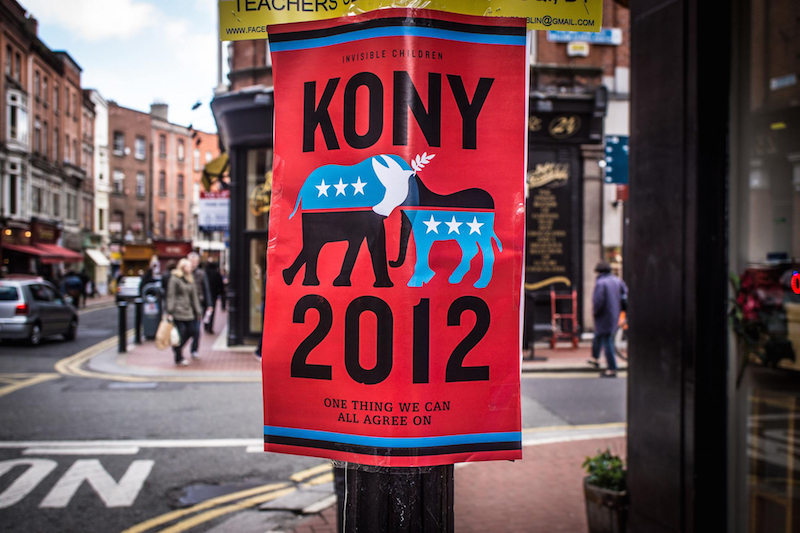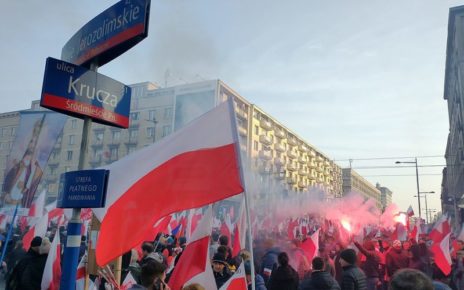Uploaded to YouTube by the then-scarcely recognized charity Invisible Children (IC) on March 5, 2012, the 30-minute video KONY 2012 received over 70 million views in one week from its launch. The premise of the video, and the mandate of IC is to make African warlord Joseph Kony, and his militia group the Lord’s Resistance Army (LRA), famous. In turn, IC planned on using this widespread publicity to bolster efforts towards dismantling the LRA and bringing justice to Kony. A focus of these efforts was retaining and enhancing the use of U.S. military advisors – deployed to Uganda in 2010 under the Lord’s Resistance Army Disarmament and Northern Uganda Recovery Act, in order to counter and defeat Kony.
Though IC had been touring college campuses for several years, the KONY 2012 campaign boomed on social media and was instrumental in providing IC with $26.5 million in revenue and $17 million in assets by mid-2012 through selling t-shirts and action-kits, as well as from receiving donations from across the globe. However, shortly thereafter, the movement was hampered by widespread criticism ranging from claims KONY 2012 promoted militarism and ignorance, while also was misleading towards the size, strength, and location of Kony’s LRA. Further damaging were questions regarding how funds were used by the IC as only 37% went towards in programs in Africa while the majority was focused on travel, public information, and staff. Public backlash was devastating to the campaign’s credibility and culminated in the mental breakdown of IC’s founder Jason Russell on March 19, 2012, when he infamously ran through the streets of his Hollywood neighbourhood naked.
After the IC’s KONY 2012 video, deemed by some as the most viral video of all time – what has happened to Joseph Kony’s LRA, and how has KONY 2012 influenced the idea of liberal intervention?
The LRA since KONY 2012
In the same month as the upload of KONY 2012, a bipartisan group in the U.S. Congress announced a new resolution condemning Kony, and more importantly, an African Union force of 5,000 was assembled to combat the LRA from four African nations who had been affected by Kony’s militants. Though by the upload of KONY 2012, the LRA was much weaker than its peak size in the 1980s and 1990s, the years following 2012 sent the LRA into further decline. In 2013, a $5 million reward was offered for Kony by the U.S. government along with rewards presented for several top aides. Later that year, Kony was said to be considering a surrender, however, this did not come to fruition as the group continued to perpetrate kidnappings, engage in the use of child soldiers, and finance its operations through transnational crime including the trade of ivory.
In late 2015, the LRA suffered multiple mutinies and defections – including an unprecedented assassination attempt, dwindling numbers to as low as 120 armed men largely operating out of South Sudan, regarded the world’s most fragile state in 2015, according to the Fund For Peace’s annual Fragile States Index. Earlier this year, a top Kony bodyguard was brought before the International Criminal Court, but, Joseph Kony remains at large and in hiding.
Liberal Intervention and the KONY 2012 Moment
Though in popular consciousness, KONY 2012 was judged as a “slacktivist” fad marked by the abysmal turnout to the April 2012 “night of action”, the popularity of the IC’s campaign is yet to be replicated and stands in sharp contrast to trends in international affairs that have defined the 2010s. At its core, KONY 2012 was an exercise in the 2005 Responsibility to Protect (R2P) doctrine, as referenced in KONY 2012’s markedly less popular part two video uploaded in April 2012. Developed in the wake of humanitarian crises in Rwanda and Yugoslavia that left the international community powerless to act, R2P was to provide a legal instrument for moral intervention. The use of the doctrine has been exploited in justifying intervention in Ukraine, was tepidly supported by the public in Libya, and outright rejected in 2013 for the purpose of bombing chemical weapons facilities in Syria.
For a moment, the IC campaign staged a stunning reversal of attitudes towards liberal intervention, however, by the end of 2014, it was reduced to a shell of its former self, dwindling in capital and announcing its dissolution in December 2014. Though the hunt for Kony wears on, in June this year, it was announced the Ugandan contingent to find Kony would be withdrawing its forces from the AU’s mission, citing the lack of international cooperation as a key issue. KONY 2012 had a variety of effects on the state of the LRA and liberal intervention as a whole, and though the direct effects of IC are difficult to gage, KONY 2012 remains one of the most unprecedented, and unexpected examples of R2P in action.
Photo: “KONY 2012 – Invisible Children” (2012), by William Murphy via Flickr. Licensed under CC BY-SA 2.0.
Disclaimer: Any views or opinions expressed in articles are solely those of the authors and do not necessarily represent the views of the NATO Association of Canada.




